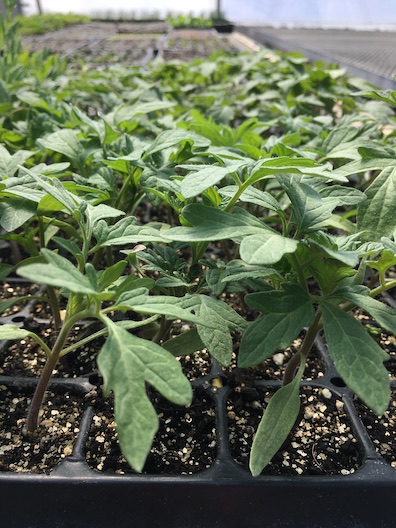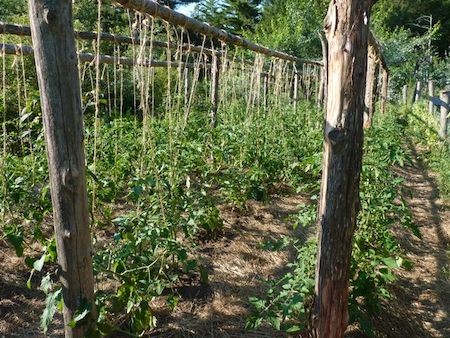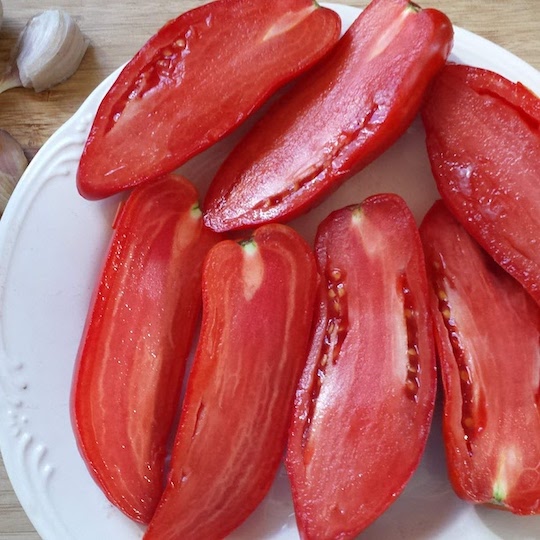Tomatoes are often considered an essential crop to grow for both new and experienced gardeners. No supermarket specimen can compare with a garden-fresh tomato. Growing tomatoes in your organic garden also allows for a much wider fruit selection: from cherry, pear and grape tomatoes, to plum and paste varieties, to heirlooms, slicers and beefsteak tomatoes, the options are seemingly endless. The following article outlines the basics of what you need to know to grow tomatoes in your organic garden this year.
1. Tomatoes require a long growing season and ample space to grow. Since they are sensitive to frost, tomatoes are typically started indoors (by April 14, according to our seed planting calendar) and are transplanted outdoors after the threat of frost has passed. Tomatoes should be planted 2 to 3 feet apart in rows 4 to 5 feet apart. If your transplants have grown tall and leggy while you waited for frost danger to subside, plant them 2 to 6 inches deeper in the soil than they were in the pot. Tomato plants can also do well when planted singly in large, deep containers.

2. Tomatoes like full sun and well-drained soil rich in organic matter. While every gardener could benefit from regularly testing their soil and amending accordingly, here’s a basic recommendation for fostering tomato-friendly conditions: Work well-rotted manure or compost and a handful each of rock phosphate (if needed) and greensand into the hole before transplanting your tomato plant.
3. Plant different types of tomatoes for continued harvest. In addition to selecting different varieties for different cooking and eating qualities (i.e., Roma tomatoes for making tomato sauce and Sweet 100 cherry tomatoes for easy snacking), consider planting varieties with different days to maturity to ensure that your harvest is spread out of the season. Plant both early and midseason varieties of tomatoes to have a supply from midsummer to fall.
4. Indeterminate vs. determinate – what’s the difference? All tomato varieties fall into one of two categories: indeterminate and determinate. Indeterminate varieties are vining types and will continue to produce new vegetive growth. This means that indeterminate tomato plants yield fruits that will ripen throughout the growing season. Some common indeterminate varieties include Big Beef, Brandywine, Juliet and Sun Gold. Determinate tomatoes, often referred to as bush tomatoes, do not continue growing throughout the season. They are compact in size and set fruit which mature over a relatively short window of time. Common determinate tomato varieties include Celebrity, Glacier, Oregon Spring and Washington Cherry.
5. Tomatoes need your support. While tomatoes can be grown with or without staking or trellising, it is highly recommended for indeterminate varieties. Generally, staking keeps the fruit cleaner and helps reduce incidence of disease. Plants can also be grown in wire cages. Tomato plants also benefit from pruning, which helps strike a balance between vegetative growth and fruit set, while also increasing air flow to help thwart disease (more on disease control later). To properly prune your plants, you’ll need to identify the new growth at the axils of each leaf (this growth is often referred to as a “sucker”). Then locate the first flower cluster of the plant. Leaving the sucker below that flower cluster, gently pinch or snip off the suckers below; tomato pruning should take place when suckers are still small, about 2 to 4 inches in size.

6. Tomatoes like it hot! You can get a jump on the growing season by using black plastic mulch and row covers. Tomato plants do particularly well when grown in a hoophouse.
7. Mulching tomato plants may help reduce diseases. Whether you choose a natural mulch, like straw, or black plastic, mulch can help to reduce diseases that might otherwise splash onto plants from the soil during rains. One such disease is early blight: a fungus infection of the leaves that may also spread to the fruit. Mulching has the added benefit of keeping weed growth to a minimum.
8. Practice garden clean up and crop rotation to further inhibit disease. Some tomato diseases can overwinter on plant debris so compost plants at the end of the season and rotate the location of your tomato plants from year to year. Tomatoes are members of the Solanaceae family, along with peppers, eggplants and potatoes; do not plant tomatoes where other family members were grown in the previous season.
9. Watch out for tomato hornworms. In the caterpillar stage, tomato hornworms have a voracious appetite for tomato foliage and can defoliate plants if not kept under control. Hornworms also affect the fruit, eating large gouges that can be mistaken for rodent damage. Be vigilant for damage and also for hornworm frass (insect poop); thoroughly handpicking the caterpillars is an effective control, though small caterpillars can be hard to spot due to their effective camouflage. The process can be aided by using a black light at night. If you have chickens, collect the caterpillars for them to eat. For more information about how to deal with pests throughout the growing season, sign up for our organic pest report.
10. Plan for abundance! In a good year, tomato plants will yield an average of 100 pounds per 50-foot row. If you’re interested in growing tomatoes for canning, read about how to determine how many tomatoes to plant here.

View our fact sheets for more information on organic vegetable gardening.
